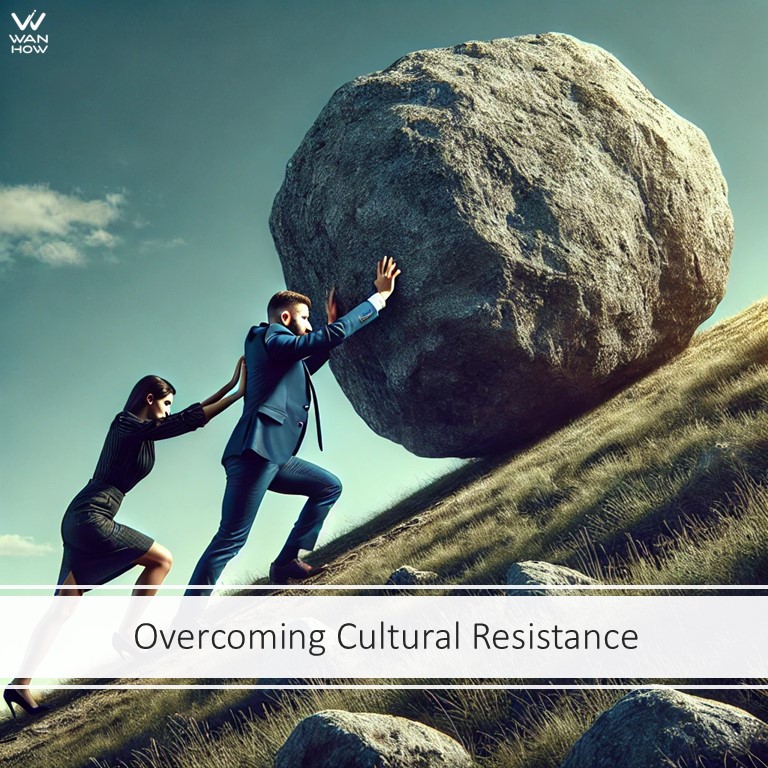
In the ever-evolving landscape of business, project management stands as a critical discipline that ensures organizations can adapt to changes, innovate, and stay competitive. However, one of the most significant challenges in project management doesn’t stem from technical difficulties or even the complexities inherent in large-scale projects. Rather, it comes from within the organization itself, rooted deeply in its culture.
Cultural resistance to change is a formidable obstacle that can derail even the most meticulously planned projects. Often, organizations express a strong desire for change, recognizing the need to evolve to meet new challenges and seize emerging opportunities. Yet, when it comes to executing the necessary changes, they falter. This gap between the intention to change and the commitment to follow through is where many projects meet their demise.
In this comprehensive guide, we will delve into the cultural challenges that hinder project success, with a particular emphasis on the crucial role that senior executive support plays in overcoming these obstacles. By understanding these dynamics and implementing the strategies outlined below, project managers and organizational leaders can better navigate the complexities of cultural resistance and lead their teams to successful project completion.
The Cultural Challenge: A Desire for Change Without Commitment
Organizations today operate in environments characterized by rapid technological advancements, shifting market dynamics, and evolving customer expectations. In response to these pressures, many companies articulate a strong desire for change. They recognize that to remain competitive and relevant, they must innovate and adapt continuously. However, the journey from recognizing the need for change to actually implementing it is fraught with challenges, particularly when it comes to shifting organizational culture.
Cultural resistance to change can manifest in several ways, each of which poses unique challenges for project managers:
- Inconsistent Prioritization: One of the most common forms of cultural resistance is inconsistent prioritization. While senior leaders may verbally commit to a project, their actions—or lack thereof—often suggest otherwise. Projects aimed at driving significant change may be deprioritized in favor of maintaining the status quo. This inconsistency can send mixed messages to teams, leading to confusion, disengagement, and ultimately, project failure.
- Fear of Disruption: Change, by its very nature, disrupts established norms and routines. Employees and managers alike may resist changes that threaten to disrupt their day-to-day operations, job security, or professional identity. This fear of disruption can lead to passive resistance, where individuals outwardly agree with the need for change but fail to take the necessary actions to support it.
- Lack of Resources: Even when there is a desire to implement change, organizations may not allocate the necessary resources—be it time, money, or personnel—to ensure success. This resource scarcity can cripple a project before it even gets off the ground. For instance, a project might be launched with great fanfare, but without the dedicated teams, adequate budget, or sufficient time to execute, it is doomed to struggle.
- Communication Gaps: Effective communication is crucial in any change initiative. However, in many organizations, there is a failure to communicate the benefits of change effectively. This communication gap can lead to skepticism and resistance among team members. Without a clear understanding of why change is necessary and how it will benefit them and the organization, employees are unlikely to fully commit to the process.
These cultural hurdles are further exacerbated when the organization’s leadership is not fully aligned with the goals of the project. Without strong, visible support from senior executives, efforts to drive change are likely to be met with indifference or outright resistance.
The Senior Executive Mindset: A Critical Factor in Project Success
The mindset and support of senior executives are pivotal to overcoming cultural resistance to change. In many organizations, the success or failure of a project hinges on the level of commitment and involvement from the top. Without strong leadership support, efforts to transform organizational culture and improve project delivery are unlikely to succeed. Here’s why senior executive support is essential:
- Setting the Vision: Senior leaders have the unique ability to articulate a clear vision for the future—one that aligns with the organization’s long-term goals. This vision is not just a lofty ideal; it serves as a guiding star for the entire organization. When senior executives are fully committed to a project, they can effectively communicate the strategic importance of the change, thereby rallying the entire organization behind it. This vision is crucial for ensuring that all employees, from frontline workers to middle management, understand the purpose of the project and their role in its success.
- Allocating Resources: Projects that are backed by senior executives are more likely to receive the necessary resources. This includes not only financial investments but also the allocation of key personnel and the time required to implement changes effectively. Senior leaders are often in the best position to remove obstacles that may hinder project progress, such as bureaucratic red tape, competing priorities, or insufficient funding. Their involvement ensures that the project has the resources it needs to succeed.
- Driving Accountability: When senior leaders demonstrate a commitment to change, it sets a tone of accountability throughout the organization. This accountability is essential for aligning all levels of the organization with the project’s objectives. When employees see that their leaders are fully invested in the project, they are more likely to take ownership of their roles and responsibilities. This sense of accountability extends beyond the project team to include all stakeholders, ensuring that everyone is working towards the same goals.
- Overcoming Resistance: Senior executives can play a pivotal role in addressing and mitigating resistance to change. Resistance often stems from fear of the unknown, concerns about job security, or doubts about the feasibility of the change. By engaging directly with those who are hesitant or opposed to the project, leaders can provide the reassurance and support needed to move forward. This might involve one-on-one meetings, town hall discussions, or other forms of direct communication that address concerns and build trust.
Strategies for Overcoming Cultural Resistance and Securing Executive Support
Successfully overcoming cultural resistance and securing senior executive support requires a multifaceted approach. The following strategies can help project managers and organizational leaders navigate these challenges and lead their teams to success:
- Engage Executives Early and Often: From the outset of any major project, it is crucial to involve senior executives in the planning and decision-making process. This engagement should go beyond merely seeking approval; it should involve actively soliciting their input and ensuring they understand the project’s objectives, the benefits of the proposed changes, and the risks of not acting. Regular updates and transparent communication can help maintain their support throughout the project lifecycle. This ongoing dialogue also provides an opportunity to address any concerns or obstacles that may arise, ensuring that the project stays on track.
- Build a Coalition of Change Champions: Identifying and cultivating a group of influential leaders and managers who are committed to the project’s success can be a powerful way to drive change. These change champions can serve as advocates for the project across the organization, helping to build support and address resistance at various levels. By leveraging their influence, change champions can help to create a groundswell of support that can overcome even the most entrenched resistance.
- Align Projects with Strategic Goals: Positioning your projects as key drivers of the organization’s broader strategic goals is essential for securing senior executive support. When executives see how a project contributes to the company’s long-term success, they are more likely to support it. This alignment also helps to ensure that the project remains a priority, even in the face of competing demands. It is important to clearly articulate how the project will help the organization achieve its strategic objectives, whether that’s increasing market share, improving customer satisfaction, or driving innovation.
- Communicate the ‘Why’: Clearly communicating the reasons for change to all stakeholders is critical for overcoming resistance. This communication should emphasize the long-term benefits of the project, both for the organization and for individual employees. Addressing fears and concerns directly can help to build trust and buy-in. This might involve hosting town hall meetings, distributing regular project updates, or creating informational materials that explain the rationale behind the change. It’s also important to provide opportunities for employees to ask questions and express their concerns, ensuring that they feel heard and valued throughout the process.
- Demonstrate Early Wins: Showcasing early successes can help build momentum and demonstrate the value of the changes being implemented. These quick wins can also help to shift the culture towards greater acceptance of change. By delivering tangible results early in the project, you can create a sense of progress and achievement that motivates the team to continue pushing forward. Early wins also provide valuable evidence that the project is on the right track, which can help to secure ongoing support from senior executives and other stakeholders.
- Provide Ongoing Support and Training: Equipping employees with the tools, training, and support they need to adapt to new ways of working is crucial for reducing resistance and ensuring that changes are implemented smoothly. This might involve offering workshops, providing access to online learning resources, or setting up mentoring programs to help employees develop the skills they need to succeed in the new environment. Ongoing support is also important for addressing any challenges that arise during the implementation process, ensuring that employees feel confident and capable as they navigate the changes.
- Monitor and Adjust as Needed: Change is an ongoing process, and it’s important to monitor progress and make adjustments as needed. This might involve conducting regular check-ins with project teams, soliciting feedback from employees, or reviewing key performance indicators to assess the impact of the changes. By staying flexible and responsive, you can ensure that the project remains aligned with the organization’s goals and that any issues are addressed promptly.
- Celebrate Successes: Celebrating successes, both large and small, is an important way to reinforce the value of the change and build a positive culture around project management. This might involve recognizing the contributions of individual team members, hosting events to mark key milestones, or sharing success stories with the broader organization. Celebrating successes helps to build morale and create a sense of pride in the work being done, which can motivate teams to continue striving for excellence.
Conclusion: Leading the Charge for Cultural Change
Successfully navigating cultural resistance to change is one of the most challenging aspects of project management. However, with the right strategies and strong support from senior executives, it is possible to transform an organization’s culture and drive successful project outcomes.
By engaging senior leaders early, aligning projects with strategic goals, communicating effectively, and demonstrating early wins, project managers can overcome the cultural barriers that often stand in the way of progress. In doing so, they not only ensure the success of individual projects but also contribute to the long-term resilience and adaptability of their organizations.
Ultimately, overcoming cultural resistance requires a combination of strategic vision, strong leadership, and a commitment to ongoing support and communication. By fostering a culture that embraces change and values continuous improvement, organizations can position themselves for success in an increasingly competitive and dynamic business environment. The role of senior executives in this process cannot be overstated—when leaders are fully committed to driving change, they can inspire their teams to achieve great things and ensure that their organizations thrive in the face of new challenges.
Related Post: Navigating Cultural Challenges and Strong Personalities in Project Management
